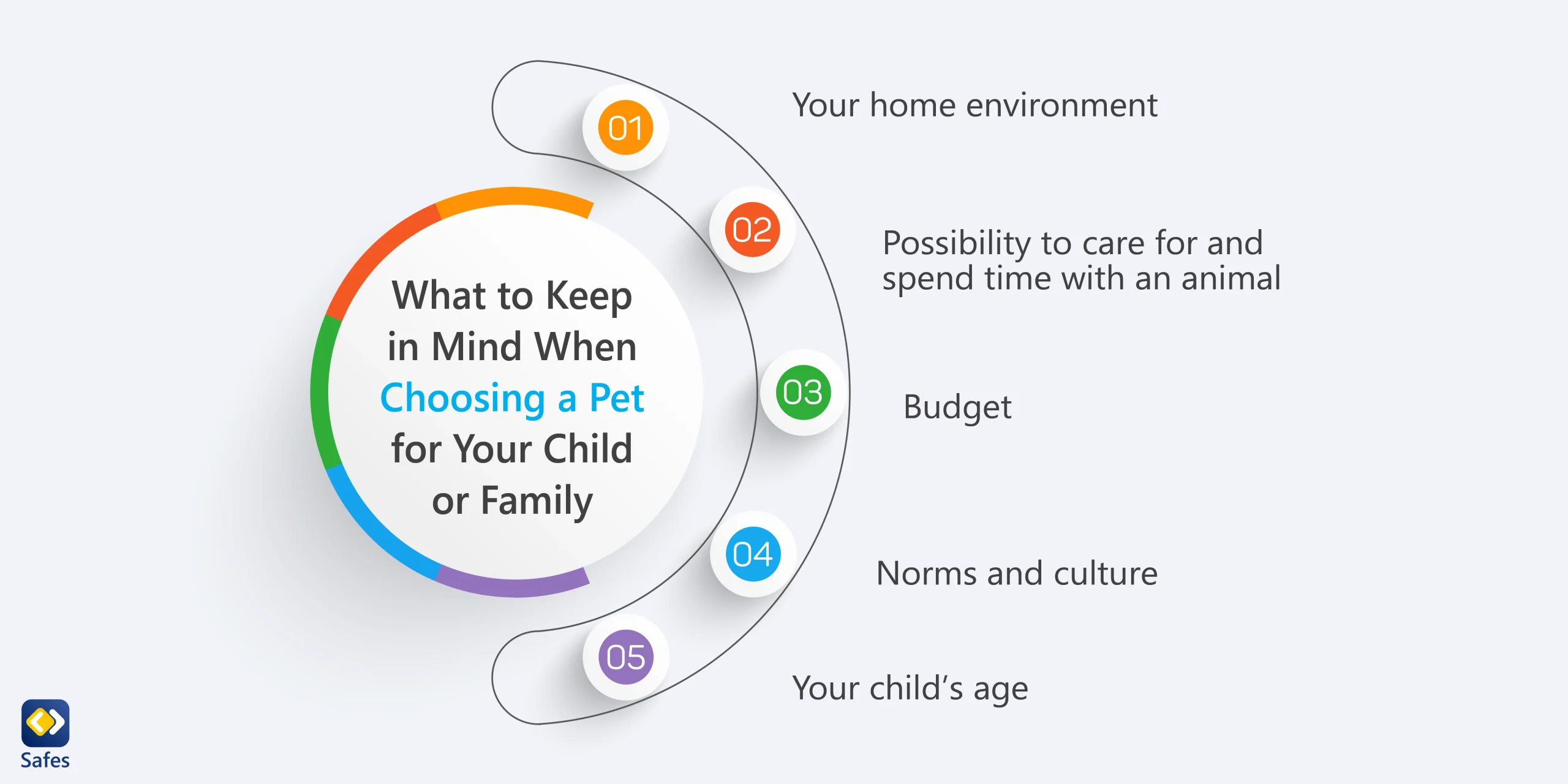With children spending a large chunk of their time in front of different smart gadgets, getting them pets can be a solution to reduce their screen time. Choosing good pets for children can be a rewarding yet challenging task. It requires a deep understanding of the child’s personality and lifestyle, as well as the pet’s needs and behavior.
Download and Start Your Free Trial of the Safes Parental Control App
“Adopting a pet that a child can also help take care of can be an enriching experience for your kid. It teaches empathy and responsibility.” – Dr. Laurie Hess, DVM and owner of the Veterinary Center for Birds and Exotics
Therefore, it’s crucial to make an informed decision and ensure that your child and the potential pet are a good match.
Choosing the Right Pet for Your Child
Everyone loves cuddling a cute pet, but before jumping into a decision to get one for your family, it helps a lot if you consider these factors:
Your home environment: Is your house or apartment large enough to be comfortable for a large pet? Would neighbors be OK with you keeping an animal that may run around or make noises? What about your landlord? Not all of them are friendly with animals!
Possibility to care for and spend time with an animal: Children cannot care for all the needs of a pet, so by keeping one, you, as a parent, should bear some responsibility. Do you have enough time to look after the basic needs of a companion animal? Can you spend some time with them, feed them, bathe them, take them for a walk, etc.?
Budget: While some animals do not have many expenses, others do. Most pets need to be taken to a vet regularly for check-ups, taking medication, and jabs. While in some countries, there is pet medical insurance available, in other countries, they aren’t. Also, you should consider the prices of food and treats your pet needs. You should anticipate all these expenses before adopting a pet.
Norms and culture: Some animals are more favored in different parts of the world. For example, while families in _say_ the US or Europe commonly keep cats and dogs as pets, in other parts of the world, such as the Middle East, birds and fish are more common. You may, however, choose to go against the crowd, but you should anticipate the conflicts you may have with the people around you.
Your child’s age: Another issue to keep in mind is that the type of pet that fits well with your family may vary based on the age of your children. Children of different ages tend to favor different animals. Moreover, some species and breeds require more attention and delicate handling. If you neglect these issues, chances are your child might hurt the animal or get hurt. Let’s take a look at some suitable pets for different age groups:

Best Pets for Toddlers (Aged 1-3)
Toddlers are, of course, too young to fulfill their own needs, let alone care for an animal. Nevertheless, they can enjoy the company of child-friendly pets. According to the American Academy of Child and Adolescent Psychiatry, pets can “help in developing non-verbal communication, compassion, and empathy.” But what’s important to keep in mind is that when you get a pet for a toddler, you need to bear all the responsibility of protecting the animal.
Some of your suggestions for a child-friendly pet for toddlers include:
Golden Retriever Dogs
The Golden Retriever is an awesome dog breed that’s got it all! This lovable breed is super confident, smart, and friendly. They’re always there to brighten your day with their kindness and loyalty. Unlike aggressive or timid dogs, Golden Retrievers have the best of both worlds. Plus, their incredible patience makes them a perfect match for toddlers. Not only they’re not usually aggressive to children, but also there have been instances of Golden Retrievers protecting them.
Persian Cats
Persians make fantastic family pets because of their calm and serene demeanor. They get along well with children, displaying remarkable patience and tolerance towards energetic and noisy children. In fact, if things get overwhelming, Persians will proactively retreat and find a quiet spot to be alone.
Best First Pets for Children Aged 4-7
Some believe children above 4 are old enough to own their first pets, and some don’t. So, it really depends on your child’s passion for animals and their ability to take part in caring for them. But again, keep in mind that you can’t expect young children to fully take control over the responsibilities of a pet, so you should mainly consider it your chore.
Some good first pets for children aged 4-7 include:
Parakeet
Parakeets, also known as Budgerigars, are a popular choice for young children. These birds are small, low-maintenance, and known for their affectionate nature. They should be kept in closed spaces and are usually very talkative. They’re very harmless, so your child can sometimes caress them.
Crested Gecko
If you’re comfortable with a reptile, consider a crested gecko. They’re a friendly, easygoing species that children often enjoy. Some parents have a guard against reptiles thinking they’re basically aggressive or unfriendly animals. But this can’t be any further from the truth since Crested Geckos are very harmless and comfortable with humans.
Easy Pets for Children Aged 8-11
Thankfully tweens are mature enough to hand over most of the responsibilities of taking care of a pet, albeit if you teach them how and monitor them. Tweens usually have their distinct taste for pets, so it’s better to give them more freedom to choose their favorite species as long as it stands within reason _that means if it’s not a tiger or a bear!
Here are our suggestions:
Rats
Rats can be outstanding pets for older children. They’re highly intelligent and are known to form strong bonds with their owners. You can alternatively choose other rodents, such as hamsters. Unlike rats, they’re famous for keeping themselves to themselves, but isn’t it a lovely scene to watch a hamster eat?
Canaries and Finches
For bird lovers, canaries and finches make for a great choice. They offer beauty and song, and their care requirements can be easily managed by older children. Other than food and water, they need regular cleaning and interaction, but if your child loves them, that shouldn’t be a problem.
Best Pets for Children Aged 12 and Above
Most teenagers can take over all the responsibilities of caring for a pet. Some believe that this is the most suitable age for getting a pet for your child because they are mature enough to understand that an animal is not a thing and like humans require meticulous caring and attention. Let your child make their choice for an animal to adopt but offer these suggestions to them:
Rabbits
Rabbits can make for highly engaging and affectionate pets. However, they require a significant amount of care and attention. Rabbits are smart and cute animals but consider that they are rodents, and rodents are notorious for chewing things. So, perhaps it’s best to tidy up your charger cables before getting one!
Cats and Dogs
Cats and dogs are classic choices for older children. They require a high level of responsibility but can also provide companionship and mutual bonding experiences. Cats and dogs make strong bonds with humans. Something that makes them stand out among all other choices is that unlike most pets that should be kept inside a closed space, most cats and dogs can comfortably and safely live with people indoors and outdoors. They have been living with humans for centuries, so you could say they’ve learned the skills to live with us without feeling captivated.

Teaching Kids About Responsible Pet Ownership
Responsible pet ownership is an essential lesson to impart to your kids. It includes feeding, grooming, and providing medical care for the pet.
“All pets require veterinary care. You will need to make sure there is a veterinarian in your area that can help with your chosen pet.” – Dr. Elizabeth Mackey, veterinarian
Unfortunately, some parents neglect this issue. It may sound shocking, but based on experience, some parents see no difference between a pet and a toy they give their children to play with. Therefore, many pets live a tormenting life before they soon perish. Let’s review the factors to remember when choosing a pet in case you’ve forgotten:
- Your home environment
- Possibility to care for and spend time with an animal
- Budget
- Norms and culture
- Your child’s age
Fostering Healthy Relationships Between Children and Pets
Building a healthy relationship between your child and their pet is key to a harmonious household. It includes teaching your child how to interact with the pet, respecting its space, and understanding its needs.
You shouldn’t regard adopting a pet as handing over the responsibility to your child. No matter how old your child is, you still have some responsibility for granting the pet’s needs. Of course, as children grow up, they can gradually take more responsibility. Still, as long as that pet is living under your roof, it’s your family’s pet, and everyone in your family is responsible for caring for them.
Try to Adopt Animals Instead of Buying Them
Some people fail to notice it, but reproducing animals is a tempting business, and some people are taking advantage of this issue. They force animals of favored breeds to mate in unethical conditions. On the other hand, there are tons of animals out there that can benefit from a caretaker. So, if you like keeping a pet, perhaps it’s better to consider adopting an animal instead of buying one.

Activities to Reduce Screen Time Through Pet Engagement
Engaging with pets can be an effective way to reduce screen time for children. Activities such as pet care, playtime, and training can offer a fun and educational alternative to digital devices.
Here are some examples of activities you and your child can do with your family pets:
- Play fetch: Dogs love to chase and fetch, so grab a ball or a frisbee and head to a park or your backyard for a game of fetch.
- Go for a walk: Taking your dog for a walk is not only great exercise for them but also an opportunity for you to get some fresh air and bond with your furry friend.
- Teach new tricks: Spend some time teaching your pet new tricks or commands. Doing this not only stimulates their mind but also strengthens your bond and improves their obedience.
- Have a playdate: If your pet gets along with other animals, arrange a playdate with a friend or neighbor who also has a pet. It’s a great way for them to socialize and have fun.
- Explore nature: Take your dog for a hike or a trip to the beach. Let them explore new sights, smells, and textures while enjoying the great outdoors.
- Puzzle toys: Engage your pet’s problem-solving skills by giving them puzzle toys or treat-dispensing toys. This keeps them mentally stimulated and entertained
- Agility training: Set up an obstacle course in your backyard or find a local agility class. This activity is perfect for high-energy dogs who love to jump, run, and climb.
- Pet-friendly outings: Many cafes, restaurants, and parks now have pet-friendly policies. Take your pet along for a coffee date or a picnic in the park.
Setting Up Healthy Routines
Creating a daily routine for pet care tasks can help children understand responsibility and time management. It can include feeding, grooming, and playtime schedules that align with the child’s daily routine. It can also help them avoid excessive screen time. Some solutions can complement your screen time routines. One of them is using parental control apps. In the following, we’ll explain how your child can benefit from the Safes parental control app, a comprehensive app that works fine on all platforms, including Android, iOS, Windows, and Mac.
How to Build Healthy Routines with Safes
You can encourage healthy routines by using parental control applications like Safes. This application allows you to set restrictions on screen time, helping your child develop balanced digital habits. With simple steps, you can allocate specific screen time to each app on your child’s phone, tablet, or computer. After your child reaches the limit, the app won’t be accessible anymore, forcing them to leave off their gadgets.
If you like the screen time management features of Safes, you can try it by downloading it from our website, AppStore, and Google Play. You can also learn about how to put parental controls on different platforms using Safes with the links below:
- Windows parental controls
- Macbook parental controls
- Parental controls on android
- iPhone parental controls
Feel free to start your 14-day free trial now and see how Safes can help manage screen time, no credit card required.
Conclusion: Good Pets for Children
Choosing the right pet for your child can be a rewarding experience that teaches empathy, responsibility, and care. However, it’s essential to consider the needs and lifestyle of both the child and the pet. By fostering a healthy relationship between your child and their pet, you can provide a nurturing environment for both.
Using tools like the Safes parental control app, you can support your child in managing screen time effectively while fostering a healthy relationship with their pets.
Your Child’s Online Safety Starts Here
Every parent today needs a solution to manage screen time and keep their child safe online.
Without the right tools, digital risks and excessive screen time can impact children's well-being. Safes helps parents set healthy boundaries, monitor activity, and protect kids from online dangers—all with an easy-to-use app.
Take control of your child’s digital world. Learn more about Safes or download the app to start your free trial today!




